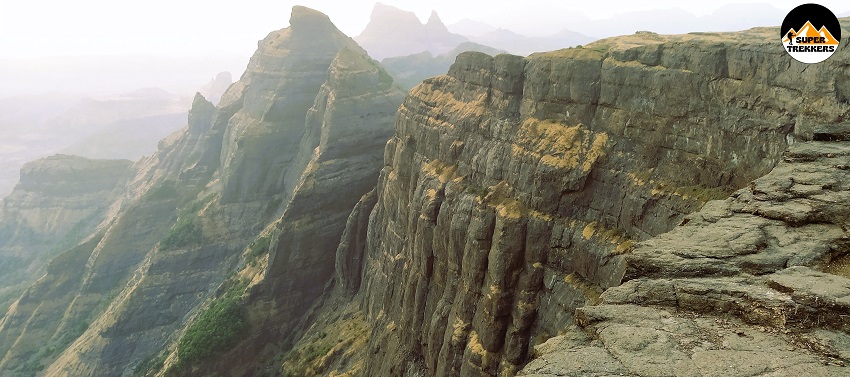
‘ ); } ?>
Table of Contents
Chandragad Fort
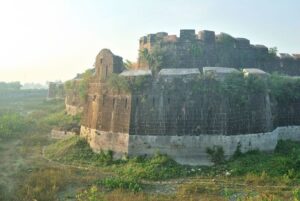
Nestled in the majestic Sahyadri ranges, Chandragad Fort stands as a testament to Maharashtra’s rich history and architectural brilliance. Once a strategic stronghold, this fort played a crucial role during the reign of the Marathas, witnessing many battles and legendary tales.
The trek to Chandragad Fort is an adventure through dense forests, rocky terrains, and breathtaking landscapes, making it a paradise for trekkers and history enthusiasts alike. At the summit, visitors are rewarded with panoramic views of the surrounding valleys and remnants of ancient structures that whisper stories of the past.
Despite its historical significance, Chandragad remains lesser explored, adding to its mystique. The fort’s ruins, bastions, and natural beauty create an unforgettable experience for explorers seeking history and adventure.
If you’re passionate about unraveling the secrets of Maharashtra’s past, Chandragad Fort is a must-visit destination that promises an enriching journey through time.
Historical Significance
Chandragad Fort holds a deep-rooted history, believed to be an important strategic location during the Maratha rule. Though not as popular as Raigad or Rajgad, this fort played a crucial role in the defense system of the Western Ghats. It is said that Chhatrapati Shivaji Maharaj recognized the fort’s strategic importance and incorporated it into his network of hill forts to safeguard his kingdom from enemy invasions.
The fort’s location atop the rugged Sahyadri ranges provided a natural advantage, allowing Maratha forces to monitor enemy movements along trade routes and mountain passes. Historians believe that Shivaji Maharaj’s military commanders and troops frequently used the fort as a watchtower and resting post during campaigns against the Adilshahi Sultanate and the Mughals. The fort also played a role in securing nearby villages and controlling local trade routes.
During the Maratha-Mughal conflicts, forts like Chandragad were instrumental in the guerilla warfare tactics employed by the Marathas. Its hidden location made it difficult for enemy forces to lay siege, allowing Maratha warriors to launch surprise attacks and retreat swiftly into the dense forests.
After Shivaji Maharaj’s era, the fort continued to serve as a strategic outpost during the reign of the Peshwas. However, with the decline of the Maratha Empire and the eventual dominance of the British East India Company, many hill forts, including Chandragad, lost their military significance and fell into ruins.
Today, only remnants of its glorious past remain, such as ancient fort walls, bastions, and water reservoirs, which still echo the fort’s historical importance. Despite its lesser-known status, Chandragad Fort continues to captivate history enthusiasts and trekkers who seek to uncover the unsung stories of Maharashtra’s legendary past.
Location & How to Reach
Chandragad Fort is located in Maharashtra’s Satara district, surrounded by lush green valleys and rugged terrains. The fort is situated in the Koyna Wildlife Sanctuary region, adding to its scenic beauty and biodiversity. It lies close to Mahabaleshwar and Patan, making it a great addition to an extended trip covering multiple historical and natural sites.
By Road
The fort is easily accessible by road from major cities like Pune, Mumbai, and Satara. The best way to reach the base village is by private vehicle or state transport buses.
- From Pune: The distance to Chandragad Fort is approximately 150 km. Travelers can take the Pune – Satara – Patan – Helwak route.
- From Mumbai: The distance is about 280 km, with a recommended route via Mumbai – Pune Expressway – Satara – Patan – Helwak.
- From Satara: The fort is around 85 km from Satara, and local buses or taxis can be used to reach the base village.
Buses operated by MSRTC (Maharashtra State Road Transport Corporation) frequently run from Satara and Pune towards nearby villages like Helwak and Koynanagar, from where local transport can take travelers closer to the trek start point.
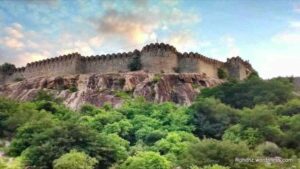
By Rail
The nearest railway station is Satara Railway Station, which is well-connected to Pune, Mumbai, and other major cities in Maharashtra. From Satara, travelers can hire a taxi or board a bus towards Patan or Helwak, followed by a short ride to the base village.
By Air
The closest airport to Chandragad Fort is Pune International Airport (PNQ), located approximately 150 km away. From the airport, travelers can rent a car or take a bus/train to reach Satara and proceed towards the fort.
The Trekking Experience
Trekking to Chandragad Fort is an exhilarating experience, offering a perfect blend of adventure and scenic beauty. The trail is moderately challenging, making it suitable for both beginners and experienced trekkers. Key highlights of the trek include:
- Dense Forests: The route takes you through thick forested trails, rich with biodiversity.
- Rocky Terrains: Some sections involve steep climbs over rocky surfaces, adding to the adventure.
- Panoramic Views: The summit offers a breathtaking view of the surrounding valleys, making the trek worthwhile.
- Ancient Ruins: Along the way, trekkers can witness remnants of old structures, water cisterns, and fortifications that tell stories of the past.
Best Time to Visit
The best time to visit Chandragad Fort is during the monsoon and winter months (June to February). Each season offers a unique experience, making the trek enjoyable for different reasons:
- Monsoon (June to September): The fort and its surroundings are transformed into a lush green paradise with cascading waterfalls and mist-covered hills. The cool breeze and scenic beauty make the trek enchanting. However, due to heavy rains, the trails can become slippery and challenging, so it is advised to wear proper trekking shoes and be cautious.
- Post-Monsoon (October to November): This is one of the best times to visit as the landscape remains green and fresh, with pleasant weather making the trek comfortable. The waterfalls may still have some water, adding to the beauty of the region.
- Winter (December to February): Winter is the ideal time for trekking as the climate remains cool and dry. The clear skies offer stunning panoramic views of the Sahyadri ranges. The pleasant weather ensures an enjoyable trekking experience without the risk of excessive heat or rainfall.
- Summer (March to May): Although summer is not the best time to visit due to high temperatures, early morning or late evening treks can still be manageable. However, trekkers should carry sufficient water to stay hydrated and avoid trekking during peak afternoon hours.
Things to Carry
When trekking to Chandragad Fort, it is essential to be well-prepared. Here are some must-have items:
- Good trekking shoes: Sturdy shoes with a good grip are crucial for navigating rocky and uneven terrain.
- Sufficient water: Carry at least 2-3 liters of water per person to stay hydrated throughout the trek.
- Energy snacks: Dry fruits, energy bars, and glucose-based drinks help maintain energy levels.
- Raincoat or poncho: If visiting during monsoon, a raincoat or poncho is necessary to protect against sudden showers.
- Flashlight or headlamp: Essential for early morning or late evening treks, as the trails can be dark and challenging to navigate.
- First aid kit: Carry basic first aid supplies like bandages, antiseptic cream, pain relievers, and any personal medications.
- Warm clothing: If trekking in winter, a light jacket or sweater will keep you comfortable in the cold.
- Sunscreen and sunglasses: Protect your skin and eyes from the sun, especially during summer treks.
- Backpack: A comfortable and lightweight backpack to carry all essentials without straining your back.
- Walking stick: Helps maintain balance and reduce strain on knees during steep climbs.
- Camera or smartphone: To capture the stunning landscapes and fort ruins.
- Garbage bags: Help in keeping the trekking trail clean by carrying back waste.
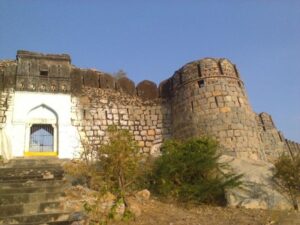
Nearby Attractions
While visiting Chandragad Fort, travelers can explore other nearby attractions:
- Mahabaleshwar: A famous hill station known for its breathtaking viewpoints, pleasant climate, and lush greenery. It is home to Wilson Point (Sunrise Point), Arthur’s Seat, Venna Lake, and Mapro Garden. The cool climate and misty hills make it a perfect getaway for nature lovers and adventure seekers alike.
- Pratapgad Fort: Located about 24 km from Mahabaleshwar, Pratapgad Fort is a historically significant site where the legendary Battle of Pratapgad between Chhatrapati Shivaji Maharaj and Afzal Khan took place in 1659. The fort features a grand statue of Shivaji Maharaj, scenic views, and historical ruins, offering a deep dive into Maharashtra’s glorious past.
- Thoseghar Waterfalls: One of the most beautiful waterfalls in Maharashtra, Thoseghar is located around 20 km from Satara. The waterfalls vary in height, with some plunging down from over 200 meters, creating a mesmerizing sight, especially during the monsoon season. It is an ideal destination for nature enthusiasts, photographers, and those looking for a peaceful retreat away from city life.
Conclusion
Chandragad Fort is a hidden gem that deserves more attention from travelers and history enthusiasts. Whether you seek a thrilling trek, a historical adventure, or a peaceful escape into nature, this fort has something for everyone. If you love exploring offbeat destinations, Chandragad Fort should definitely be on your travel list.
The fort stands as a silent witness to history, narrating tales of bravery, resilience, and architectural brilliance. Walking through its ruins, you can almost hear the echoes of the past, making it an immersive experience for history lovers. The combination of breathtaking views, untouched beauty, and historical significance makes this fort a must-visit destination for every traveler.
So, pack your bags, set out on this incredible journey, and unveil the secrets of the past at Chandragad Fort. Whether you’re an adventurer, a nature lover, or a history enthusiast, this destination offers an unforgettable experience that will leave you in awe of its grandeur.
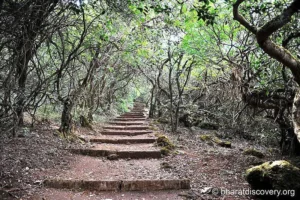
Chandragad Fort Map
Follow More Fort
